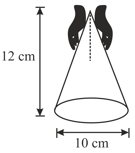B M Sharma Solutions for Chapter: Newton's Laws of Motion (With Friction), Exercise 55: Exercises
B M Sharma Physics Solutions for Exercise - B M Sharma Solutions for Chapter: Newton's Laws of Motion (With Friction), Exercise 55: Exercises
Attempt the practice questions on Chapter 7: Newton's Laws of Motion (With Friction), Exercise 55: Exercises with hints and solutions to strengthen your understanding. PHYSICS For Joint Entrance Examination JEE (Advanced) Mechanics I solutions are prepared by Experienced Embibe Experts.
Questions from B M Sharma Solutions for Chapter: Newton's Laws of Motion (With Friction), Exercise 55: Exercises with Hints & Solutions
In the following figure shows an accelerating conveyor belt inclined at an angle above horizontal. The coefficient of friction between the belt and block is Find the least time (in sec) in which block can reach the top, starting from rest at the bottom.

A block of mass is placed over a rough inclined plane as shown in the figure. The coefficient of friction between the block and the plane is A force is applied on the block at an angle of Find the contact force (in ) between the block and the plane.
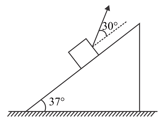
A side view of a simplified form of the vertical latch of mass is as shown in the figure. The lower member can be pushed forward in its horizontal channel. The sides of the channels are smooth, but at the interfaces of and which are at with the horizontal, there exists a static coefficient of friction What is the minimum force (in ) that must be applied horizontally to to start the motion of the latch
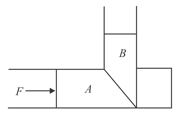
Masses and are connected by light strings which pass over pulleys and as shown. The masses move such that the string between and is parallel to incline and the string between and is horizontal, The coefficient of kinetic friction between masses and the surface is The angle of inclination of plane is to the horizontal. If the mass moves downward with uniform velocity, find the tension in the horizontal string (in ). (Given )
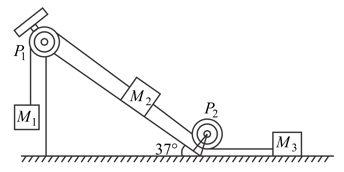
The maximum value of the mass of block (in undefined) so that neither nor moves is (Given that mass of is undefined and that of is undefined Pulleys are smooth and friction coefficients between and and between and horizontal surface is ( undefined)
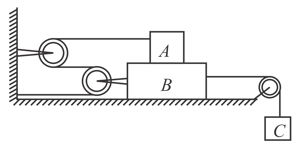
In the figure shown, block and weigh undefined and undefined respectively. The coefficient of sliding friction between any two surfaces is undefined is held at rest by a massless rigid rod fixed to the wall while and are connected by a string passing around a frictionless pulley. Find the force needed (in ) to drag along the horizontal surface to the left at a constant speed. Assume the arrangement shown in the figure is maintained all through.
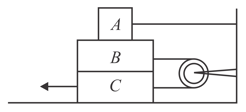
Block has a mass of and block a mass of The coefficients of friction between all surfaces of contact are and Knowing that and that the magnitude of the force applied to block is determine the acceleration of block (in ).
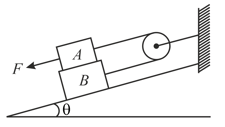
With two hands, you hold a cone motionless upside down, as shown in figure. The mass of the cone is and the coefficient of static friction between your fingers and the cone is What is the minimum normal force (in ) you must apply with each hand in order to hold up the cone? Consider only translational equilibrium.
